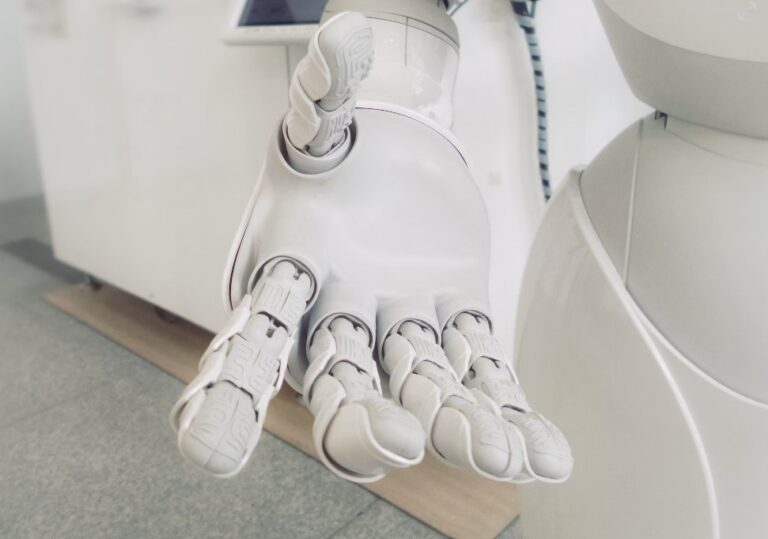Robotics is one field that is always challenging our assumptions about what is feasible in the world of rapidly developing technology. As the need for industrial automation, digitization, and sustainability increases, new developments in robotics are rising to the challenge.
The field of robotics is undergoing a period of rapid change due to developments in areas such as artificial intelligence, sensors, and production methods.
Table of Contents
5 robotic development trends
In this article, we will look into five top robotic development trends reshaping the future.
1. Robotics as a Service (RaaS)
The rise of Robotics as a Service (RaaS) is one of the most exciting developments in the robotics sector. It has been time-consuming and expensive to develop and maintain robots. These limitations prevent many organizations, especially smaller ones, from adopting robotics.
With RaaS, robotics are no longer purchased outright but rather accessed on a subscription basis. Now, businesses do not have to fork up a fortune to gain access to cutting-edge robotic technology. This shift is democratizing robotics, making them more widely applicable. Agriverse, a Greek firm, for instance, provides robotic farming services.
RaaS has many advantages, including adaptability, scalability, and the reduced complexity of incorporating robotics into pre-existing processes. Without having to fork over a ton of cash, businesses can experiment with new robotics uses and respond to shifting market conditions.
2. Cobots
“Cobots,” or collaborative robots, are changing the dynamic between humans and machines in the workplace. They have high-tech sensors and computer programs that keep them from harming humans.
Cobots, or collaborative robots, are a new breed of industrial robots that can safely and effectively perform tasks in close proximity to humans. End-of-arm tooling (EOAT) is their most common form, and it enables them to automate operations like screw drilling and part welding during assembly. Heavy metals, plastics, and other contaminants can be dangerous to human employees, but not to these robots.
Cobots improve productivity because they automate monotonous, physically hard jobs, freeing up human workers to concentrate on higher-level, more rewarding work. Cobots’ adaptability stems from their simplicity in design and programming, making them useful in fields as disparate as manufacturing and medicine.
The manufacturing and logistics sectors are seeing this tendency play out to a greater extent than others. One such company that provides cobot safety analysis is the South Korean firm safetics.
Read also: The invasion of robot waiters: is this the future of restaurants or a passing trend?
3. Autonomous mobile robots
Warehouses, hospitals, and farms are just a few of the growing numbers of businesses that are adopting autonomous mobile robots (AMRs). For instance, scanners built into warehouse AMRs can keep stock from running out by automatically tracking stock levels and processing materials.
Thanks to their high-tech sensors, machine-learning algorithms, and autonomous navigation systems, these robots can function in unpredictable surroundings without continual human oversight.
By transporting items autonomously, inspecting them, and completing other repetitive duties, AMRs increase productivity. Their flexibility makes them invaluable to businesses whose operations are always altering to meet new challenges.
OttonomyIO, a company based in the United States that produces autonomous delivery robots, is an example of an AMR. With the help of the robots, stores may offer contactless curbside, last-mile, and in-store delivery of food, drinks, and other things.
4. Intelligent robotics
The term “intelligent robotics” describes a system that combines AI with robotics. These robots can acquire knowledge, modify their behaviour, and select actions in response to input from the environment. Several key technologies, including machine learning and computer vision, reinforcement learning, dynamics modelling, and others, contribute significantly to the development of smarter and more capable robots.
Reasoning, problem-solving, and even social engagement are not beyond the capabilities of today’s intelligent robots. Robots are trained to perform better and more accurately using both historical and real-time data. Because of this, they are able to travel through their environment without human input and swiftly identify objects.
Autonomous vehicles, medical diagnostics, and customer service are just a few examples of how these technologies are being put to use, and how they are changing their respective fields by complementing human capabilities and decreasing mistake rates. The Dutch company Loop Robots, for instance, has created SAM, a smart robot designed to automate hospital decontamination.
5. Robotics cybersecurity
The significance of robotics cybersecurity is growing as robots become more commonplace in everyday life and essential infrastructure. Because of their dependence on networks and other devices, hacks can easily target robots.
Protecting robots from cyber threats including hacking, data breaches, and unwanted meddling is a growing trend. Especially with emerging technologies like driverless vehicles, medical robotics, and industrial automation, protecting the security and reliability of robotic systems is crucial.
Startups do this by deploying artificial intelligence and machine learning for constant monitoring of networks and devices. To avoid costly downtime and security breaches, businesses may make use of these technologies to keep tabs on all of their devices in real-time. One such company is Alias Robotics, a Spanish firm that provides an endpoint protection platform for robots called Robot Immune System (RIS).
Enhancing the power of robotics
Rapid technological development and creative new uses are driving the rapid development of the robotics industry. Some of the most exciting developments in this fast-paced industry include robotics as a service, collaborative robots, mobile robots that operate independently, artificial intelligence, and cybersecurity in robotics.
As these tendencies advance, robotics will unquestionably revolutionize many different sectors, boost productivity, and enrich our everyday lives. In the future years, robotics will see even more groundbreaking advancements.
Read a also: The most innovative humanoid robots in use today: how are they employed












